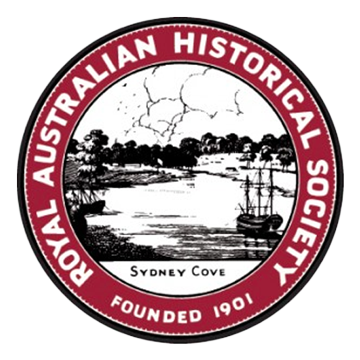RAHS Subscriptions: Journals – Vol 107 pt 2 December 2021 ABSTRACTS
Sydney, 1803: when Catholics were tolerated and Freemasons banned
James Franklin
In 1803, Governor King’s authority faced serious threats: from possible French invasion, from Irish convicts, and from officers and others with personal animosities fortified by freemasonry and republicanism. On Lord Hobart’s instructions, King allowed the convict priest Father Dixon to minister to Catholics, but masonic gatherings were banned. The reasoning behind these decisions is explained, in the light of the threats posed by each and the Irish background. Hobart’s earlier success in negotiating with Irish bishops and the perception that French and American revolutionary ideals were being spread through Freemasonry are essential for understanding developments in New South Wales.
‘A joy beyond any earthly pleasure’: Emily Paterson’s contribution to community mental health
Judith Godden
Emily Darvall Paterson’s life challenges us to rethink the history of disability in Australia. She was a blind woman whose abilities outshone her disability. She made a significant contribution to social welfare by founding, in 1907, Australia’s longest-serving mental health organisation, the After Care Association, now Stride Mental Health. Paterson’s achievement was, in large part, due to her commitment and ability to forge warm personal relations with those helped. It was also due to the support of her extended family, and local, legal, women’s and religious networks. Her legacy was both secured and threatened when After Care gained reliable government funding.
A Wet and Cold El Niño: the Tambora volcano’s impact in the Australian colonies
Don Garden
The cataclysmic Tambora volcanic explosion in April 1815 resulted in two or three years of cold and wet weather in much of the northern hemisphere which caused crop failure, famine, poverty and disease, among a range of repercussions. It also appears likely, through its impact on sea surface temperatures, to have triggered an El Niño event. This would normally result in hot and dry weather in the south-east of Australia, and potentially severe drought. However, the limited available proxy and documentary evidence indicates that in 1816 and 1817 the weather in NSW and VDL was wetter than average, especially in NSW, and quite cold in VDL. This climatic anomaly is not fully explained, but confirms that the repercussions from Tambora, while not as severe, were also experienced in the southern hemisphere.
Henry Dangar: dismissed as government surveyor in 1827 and a land appeal spanning 26 years
Jim Ritchie
This article considers Dangar’s dismissal from his position as assistant government surveyor and the following appeal process. His dismissal has been briefly dealt with by various historians, who have written (among other things) that Dangar: ‘was sacked by Governor Ralph Darling for misappropriating land’; ‘used his public position for private gain’; and ‘fraudulently used two land orders in other’s names and proposed a land trade-off being an attempted bribe’. However, the circumstances in which this dismissal occurred deserve closer consideration than has been given to date. The events leading up to this, including the charges laid against him, the hearing of those charges by the Land Board, the outcome of the hearing, whether Dangar was correctly dismissed, and his subsequent appeal to the Colonial Office (which in relation to the land decision spanned 26 years) are each examined.
‘Doovers’ in the rainforest: radar stations at Paluma, Mount Spec, during World War II
Linda Venn
This paper contends that the four radar stations based in unforgiving tropical rainforest at Paluma (‘Mt. Spec’, near Townsville) during the Second World War represent the evolution of radar technology in the South West Pacific Area (SWPA). Their histories demonstrate how challenges in lack of trained personnel and reliability of equipment were overcome by cooperation amongst members of the Allied forces. Trials at Paluma of camouflage (1942-44) and ‘tropic-proofing’ (1943-44) of prototype transportable Light Weight Air Warning (LW/AW) radar benefited radar stations throughout northern Australian and the SWPA. The critical importance of such experimentation for deployment to the SWPA is demonstrated by the success of two LW/AW radar units in Dutch East Indies and Borneo. Collectively, the men and women of these four radar stations are presented as players in this significant theatre of Australia’s military history.
Book Reviews
Ian Howie-Willis, VD: the Australian Army’s experience of sexually transmitted diseases in the twentieth century, Big Sky Publishing, Newport, NSW, 2020, 430 pages; ISBN 9781922387257.
Ken Inglis, Bill Gammage, Seumas Spark and Jay Winter, Dunera Lives: profiles, Monash University Publishing, Clayton, Vic, 2020, xxxii + 476 pages; ISBN 9781925835656.
Adrian Mitchell, Where Shadows Have Fallen: the unhappy descent of Henry Kendall, Wakefield Press, Mile End, SA, 2020, 228 pages; ISBN 9781743057483.
Murray Johnson, Australia’s Ancient Aboriginal Past: a global perspective, Australian Scholarly Publishing, North Melbourne, Vic, new edition 2020, xvii + 261 pages; ISBN 9781925003710.
Kate Bagnall and Julia T. Martínez (eds), Locating Chinese Women: historical mobility between China and Australia, Hong Kong University Press, Hong Kong, 2021, vii + 277 pages; ISBN 9789888528615.
Peter Edwards, Law, Politics and Intelligence: a life of Robert Hope, NewSouth Publishing, Sydney, 2020, ix + 386 pages; ISBN 9781742235370.
Babette Smith, Defiant Voices: how Australia’s female convicts challenged authority 1788–1853, NLA Publishing, Canberra, ACT, 2021, 288 pages; ISBN 9780642279590.
Peter Prineas, Wild Colonial Greeks, Arcadia/Australian Scholarly Publishing, North Melbourne, Vic, 2020, vii + 322 pages; ISBN 9781922454133.
Peter Dowling, Fatal Contact: how epidemics nearly wiped out Australia’s First Peoples, Monash University Publishing, Clayton, Vic, 2021; ISBN 9781922464460.
Catherine Fisher, Sound Citizens: Australian women broadcasters claim their voice, 1923–1956, ANU Press, Canberra, ACT, 2021, ix + 185 pages; ISBN 9781760464301.
